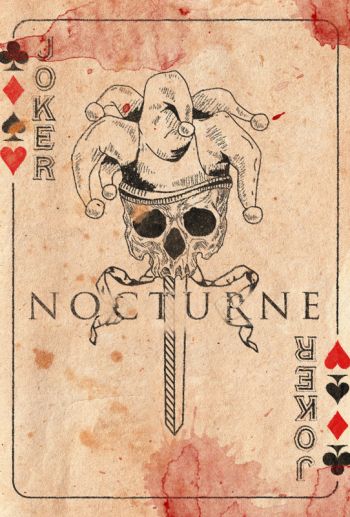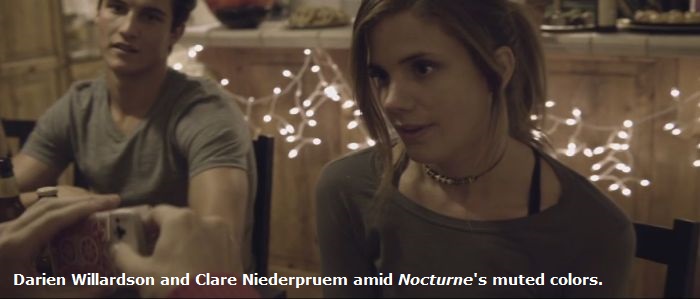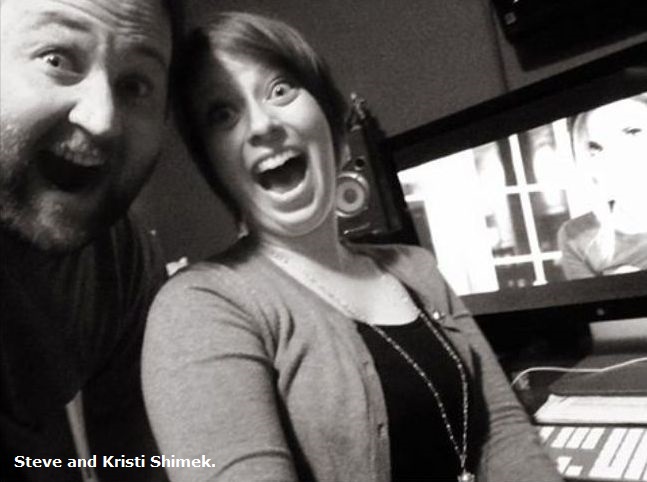NOCTURNE SEEKS A CONVERSATION ON SIN AND PUNISHMENT
by Thomas M. Sipos, managing editor [July 13, 2016]
 [HollywoodInvestigator.com] A group of young friends gather for a good time of drinking and fornicating. But when Evil intrudes into their happy bubble, the friends turn on each other, exposing secret fears, betrayals and hatreds. [HollywoodInvestigator.com] A group of young friends gather for a good time of drinking and fornicating. But when Evil intrudes into their happy bubble, the friends turn on each other, exposing secret fears, betrayals and hatreds.
It's a common story arc. These past few weeks alone, I've seen similar setups in several horror films. Young guys at a bachelor party (Bachelor Party). Young gals at a college reunion (All Girls Weekend). Yuppies at a cabin in the woods (Beyond the Woods). Whereupon enters a supernatural evil.
In Nocturne it's a graduation party at a parents' house (mom and dad away for the weekend). The friends do the usual ribbing about who's likely to succeed or fail in life, who'll marry who, who's still a virgin. Then comes a séance. Secrets are revealed, poisoning some relationships, followed by sex, drugs, drinking, lies, strip blackjack, and voyeurism. But the séance also admits a demon to the party, intent on claiming these sinners' souls ... and the body count mounts.
Nocturne was co-written by Steve and Kristi Shimek (husband and wife) and Katy Baldwin. Steve directed.
"Steve and I had worked on different types of movies, comedies and family films," said Kristi to the Hollywood Investigator. "We both felt a desire to make something that talked about issues we cared about, and had a deeper meaning. Horror is a great platform for starting conversation."
"[While] the narrative itself has a lot to say," said Steve, "our hope is that examining the layers of symbolism in the film will bring more themes to light, and enhance that conversation."
That conversation necessarily involves religion. Nocturne references Jesus, the Virgin Mary, Bible quotes, and Satan. A Catholic sensibility that evokes not only The Exorcist, but The Sentinel and Lost Souls.
"The Exorcist is an inspiration," Kristi agreed. "Such a visceral experience. We tried to achieve as much of that as possible, while also doing practical [visual] effects to give Nocturne a grounded, realistic feeling. The Ring is also a favorite. It involves the audience in a unique way. By watching the film, you participate in the 'sin.' "
"I'm fascinated with what influences our perception of right and wrong," Steve added, "How that can change. For me the story grew from the center out. The blackjack scene midpoint in the film, I love how our perception of that moment changes in an instant. The story grew organically around that pivotal point. From there, characters developed."
"We wanted to show that all of us have our sins and our vices," said Kristi. "Do we as a society think the punishments from the Bible are deserved by our fellow humans? Some of them are horrific. We want to have a modern conversation about some of the oldest mythologies that are still a large part of our culture."
Nocturne might function as a Rorschach test. I didn't sense any moral ambivalence. The film felt unambiguous in justifying the demon's retributions. Maybe other viewers will perceive a different message?
The film's thematic goals are supported by an ambitious plot structure that incorporates overlapping and parallel events, challenging our sense of time and reality. One wonders if one or more of the characters are in Hell. (More food for conversation.) In that sense Nocturne resembles Coherence, in which overlapping temporal realities (caused by a quantum event, not a demon) intrude upon a dinner party.
The cinematography and production design emphasize pastel, almost sepia hues. Soft focus and low lighting evoke the beautifully imagery of a wine commercial. A happy gathering of successful friends. Yet while this party is supposed to be a joyous affair, the low-lit, muted colors create a somber mood, challenging the friends' apparent happiness.

"We were very specific about our color palette," said Kristi. "The colors that each character wears has significance. We wanted a muted look from the beginning. Though we were shooting quickly and only with available light, we were careful with what was included on screen."
"The colors also have symbolic significance in a thematic context," said Steve. The film was shot "on a Sony a7s, recording 4K externally to a Shogun." A camera chosen for its "sensor size and low light capability. We wanted to use available light sources only. The a7s gave us the ability to light a scene with candles, street lamps, or even just one bedroom lamp. It allowed for a lot of flexibility and a very intimate production experience. We used the SLR Magic Anamorphot lens adaptor to shoot a true 2.35:1 anamorphic aspect ratio."
Steve says that Nocturne's budget "was beyond small." Kristi adds that co-producer Baldwin "got us the production funds. Let's just say it is extremely, experimentally small. Then we ran a Kickstarter campaign for finishing and festival funds." Their Kickstarter page reports that "125 backers pledged $22,068."

Despite its micro-budget, Nocturne boasts a trained and talented cast -- uncommon for films shot outside such major acting centers as Los Angeles or New York. Steve confirms that about half the cast flew in from Los Angeles, the rest were Utah locals. Some had previously worked with the Shimeks, others were friends of friends. "One advantage we had was taking a full day to do an on location read through of the entire script. We went from room to room, and blocked out the entire movie before we shot a single frame. By the time we started rolling, it almost felt more like a play than a movie set."
Like many micro-budgeters, the Shimeks filmed in their own house (in Salt Lake City's West Valley). "It was chaotic and messy," said Kristi. "We only had 15 people at most on set. Everyone was great about doing whatever was needed. The first day, one of our blood rigs accidentally went off in the living room and sprayed an entire wall with fake blood. Everyone jumped in with warm water and cleaned it up. There was nothing to do but laugh about it."
Steve adds that the house had a basement (never seen in the film) which was used as a production center. A place to store cast and equipment, and do make-up, wardrobe, and craft services.

Nocturne was shot over seven days, with an additional day for pick-up shots. It was edited and color corrected on Final Cut 7.
The Shimeks met in film school. "We started producing together about six years ago," said Kristi. "I am generally handling budget and schedule. We work in tandem to stick to the budget and schedule while capturing Steve's creative vision. We have similar aesthetic, as well as performance and tone, sensibilities."
"We have complementary skills," adds Steve, "and have developed a fluid and efficient relationship when it comes to filmmaking. I can’t imagine a better partner than Kristi."

"We often write together," said Krist. "I was editor on Steve's first feature. I've edited all our feature films. I am on set, watching the takes, to get a feel for what I will get in the editing room. When it comes to small budgets and quick shoots, every take counts. So we discuss if we've got what we need for the edit, and if we're ready to move on.
Nocturne has a website.

|
